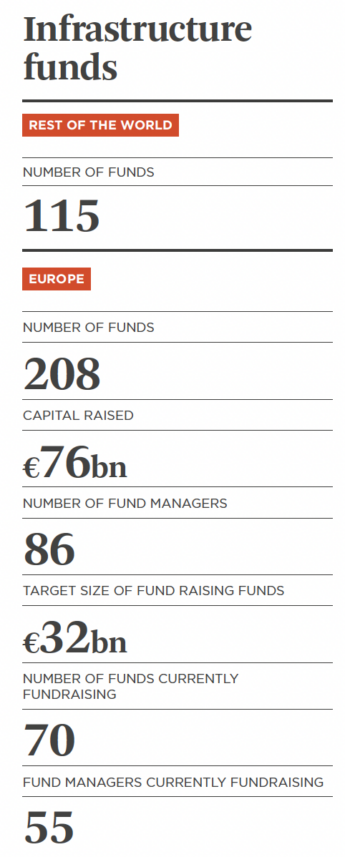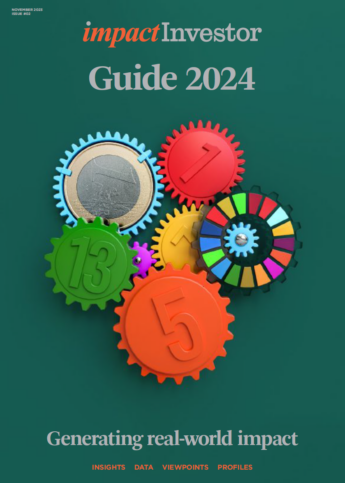Guide 2024: While the infrastructure asset class in general has faced a slowdown in fundraising recently, investor appetite for gaining exposure to infrastructure impact funds is on the up, across sectors and geographies.

In the overall world of infrastructure investing there is one dominant question at present. Where has all the money gone? The latest infrastructure fundraising figures from Preqin are alarming. Having seen record fundraising in 2022 of some $168bn (€157bn), the sector saw only $4.52bn of new capital in the first quarter of 2023, and a mere $3.61bn raised in Q2.
But in the burgeoning area of infrastructure impact investing, the story is very different.

Michael Ebner, managing director sustainable Infrastructure at KGAL Investment Management, says: “Contrary to the currently reduced appetite from investors in other sectors, we still see significant commitments from investors seeking exposure to infrastructure and in particular to impact funds.”
Ebner’s colleague, Andreas Ochsenkuehn, head of portfolio management sustainable infrastructure, lists three reasons why impact infra funds are so hot. “First, impact funds can meet sustainability goals of both institutional and retail investors. Second, governments worldwide are increasingly supporting sustainable infrastructure investments. This can enhance the attractiveness of impact funds. Third, the growing demand for infrastructure in emerging economies presents an opportunity for portfolio diversification geographically.”
On this last point Robert Wall, head of sustainable private infrastructure at Lazard Asset Management, notes: “The United Nations’ Sustainable Development Goals (SDGs) have provided a global framework for relevant stakeholders to align their efforts in addressing the world’s most pressing challenges, further encouraging investment in sustainable infrastructure projects.”
Energy transition
One overwhelming reason predominates.

Tobias Huzarski is responsible for impact investment at Commerz Real. Its impact fund, KlimaVest, has raised €1.2bn to date and runs a portfolio of around 40 renewable energy assets across Europe. He states: “Impact funds have become an integral part of the investment landscape, as they mobilise capital towards the energy transition.”
The scale of this transition is daunting. $275trn of new investment is needed to achieve net zero globally. To be consistent with national climate pledges, investment in infrastructure must double annually, across all sectors. Wall points out “just in Europe, electricity demand is expected to grow by 60% by the end of the decade”.
No wonder, as Wall continues, “the renewables and energy sectors in particular have been gaining relative weight in market share — 57% of activity in H1 this year, up from 43% in H1-2022. Of the infrastructure funds currently accepting new commitments, 45% of them focus on energy transition and renewable energy”.
In both emerging and developed markets, as Wall sums up, “infrastructure impact funds can play a vital role in partially bridging the funding gap”.
Emerging markets expansion
This geographical diversification point is picked up by Dr Thilo Tecklenburg, partner and co-head of infrastructure at Golding Capital. “Most still prefer developed countries as investment destinations, but in some areas, we see geographic diversification starting to emerge.”
Peter Bachmann, managing director, sustainable investment, at Gresham House, agrees. “The outlook for expanding their geographical reach is looking positive globally. We believe impact infrastructure represents the next major supercycle for global capital given its ability to meet the current market’s return expectations whilst also delivering positive impact both people and planet.”

There’s plenty of headroom. Although private investment has seen an impressive increase in recent years, with AUM doubling between 2013 and 2021, Wall notes that “infrastructure investment remains a largely public purse matter”. The World Bank estimated in 2017 that roughly 80% of investment came either from governments or state-owned enterprises (SOEs), the rest being funded by private capital. “Emerging markets, both from a geographical and technological view, may need some financial support to kick-off,” according to Ebner.
But as investment expands geographically so does political risk. Ochsenkuehn believes “in emerging economies, political stability and the investment climate can vary widely. Here, political risks and potential currency fluctuations are key factors that can affect the profitability of infrastructure investments”.
For Tecklenburg diversification across jurisdictions is key and something they “push for in every single one of our funds. The specific types of political or regulatory risks may differ from country to country, and between developed and emerging markets”.
Developed markets
that “as long as the framework is prudently setup and long-term oriented, rather than rashly adjusted to the politics of any given day, investors will continue to invest in the sector”.
Walls agrees noting that “the political landscape in Europe and the USA is largely positive for private capital given the enormous needs for investments”.
But this does not mean developed markets are automatically straightforward. “As impact investors, it is essential to have a sound understanding of regulatory aspects and policy factors,” in Huzarski’s opinion. “For example, around planning and approval procedures for renewable energy projects, electricity and energy regimes or feed-in tariffs.”
The recent U-turn on energy transition by UK prime minister Rishi Sunak is a case in point. Bachmann comments: “The UK is certainly facing a slightly less certain situation for environmental infra investments and we hope the next election cycle will see cross-party support for investing properly in the UK’s environmental and social future.”
But overall politicians in Europe and the US are likely to encourage private investment, particularly as the strains on the grid grow painful as we see a switch to EVs and broader electrification. A point taken up by Wall. “We are of the view that off-grid infrastructure, in particular for energy, is the next big theme in infrastructure investing. In the UK alone, installation of private PV increased from around 50MW a quarter in 2019-2020 to above 250MW in 2022 onwards.” This is not just a UK phenomenon, the success of companies like Enpal in Germany or Otovo reflect this general trend.
Beyond energy transition
Whilst energy transition may be to the fore, investing in infrastructure for impact increasingly has other avenues. Tecklenburg notes: “There is an entire universe of potential investments in the realms of mobility, utilities, social care, and others, that have clear sustainability and/or impact implications.”
Ochsenkuehn agrees. “Investments in social infrastructure such as schools and hospitals can generate stable income streams and have a positive social impact. This can be particularly attractive for impact investors.” He adds: “Infrastructure projects that improve access to basic services like water, electricity, and transportation are needed in many regions. These investments can provide long-term revenue sources.”

However, there are also perils in this area. When it comes to public infrastructure in general and such delicate services as water, Tecklenburg thinks “most infrastructure assets provide a service that improves the quality of life for the local population… a number of water utility systems in France and courthouses or hospitals in North America are good examples”. But he suggests: “Ownership of these assets should always remain with the public sector, and full privatisation could even be problematic for impact funds.”
Wall warns: “Those sectors tend to be high risk in terms of reputation and are heavily regulated, allowing returns that could be classified as pure ‘core’, and thus most affected by the recent hikes in interest rates. As an impact fund, getting exposure to those sectors may come at the expense of financial returns.”
Other diversifications are less controversial. Bachmann is “seeing some encouraging new opportunities in areas such as investment in nature arising from the UK’s Environment Act. This has the potential to be a global blueprint for significant new investment in restoring nature”.
He also mentions new fields of infrastructure currently emerging “to meet the growing challenges around food supply, and the potential for major water and land shortages in the near future”. A good example is vertical farming, which has the potential to be the future of food production while driving scale capital deployment alongside attractive returns.
Looking to the future, Tecklenburg is very optimistic. “Every conversation with investors today touches on sustainability and/or impact. Nobody ignores these topics any longer. In our estimation, broader infrastructure funds can affect all but two of the SDGs, showing their huge importance for impact strategies.”

This article is part of the editorial content of the Impact Investor Guide 2024. You can download a digital copy of the guide here.





